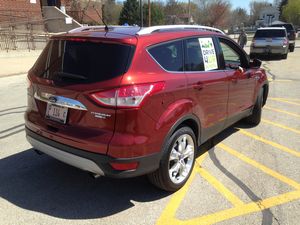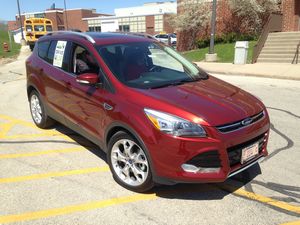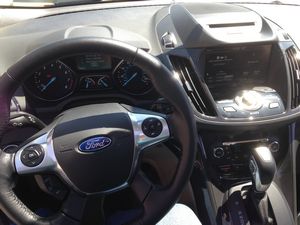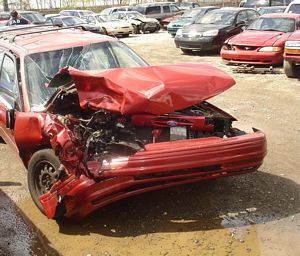|
By accessing or using The Crittenden Automotive Library™/CarsAndRacingStuff.com, you signify your agreement with the Terms of Use on our Legal Information page. Our Privacy Policy is also available there. |

The CUV: Just the Right Size
|
|---|
|
|
Opinions expressed by Bill Crittenden are not official policies or positions of The Crittenden Automotive Library. You can read more about the Library's goals, mission, policies, and operations on the About Us page.
Topics: Ford Escape
|
The CUV: Just the Right Size
Bill Crittenden
May 12, 2015


 2015 Ford Escape Titanium Ecoboost 4WD 2015 Ford Escape Titanium Ecoboost 4WD
 U.S. Market Ford Escort after a head-on collision with a SUV - showing the raised point of impact U.S. Market Ford Escort after a head-on collision with a SUV - showing the raised point of impact
CC BY-SA 3.0 photo by "Karrmann."
|
A few weeks ago I stopped by a Ford event called "Drive 4UR School," where any test drive of a new Ford earns a donation to the school hosting the event. In this case it was Woodstock High School across town, and this time I picked the Ford Escape. I picked the Escape because I've been thinking of replacing our Mazda CX-7 with something all-wheel drive, and my wife likes the Ford C-Max. I do, too, but I think I like having the all wheel drive more than having a hybrid.
Long story short on the Escape: I'd buy one. No pun intended, but really I have a "short list" of vehicles I can even consider purchasing because of my height. One vehicle I crossed off my list that day was the Ford Fusion. Despite being a midsize car, the low sloping roofline made it difficult to get in to and out of and my head was uncomfortably close to the roof.
That got me thinking about my list and how many of the vehicles on it were either narrow and tall wagons (Ford C-Max, Mazda 5) or Compact Utility Vehicles.
For those who haven't heard the term, "Compact Utility Vehicle" or "CUV" refers to a subcategory of the SUV. It refers to, basically, compact SUVs. Some say the subcategory started in 1982 with the Chevrolet S-10 Blazer, some say it was two years later with the unibody Jeep Cherokee, but you could even consider the Jeep CJ/Wrangler dating back to the 1940's as a compact utility vehicle. It's definitely compact, utilitarian, and a vehicle. That gets my vote.
It's a category that's now mostly four-cylinder, transverse-engined unibody vehicles more carlike than military in design, including the Toyota RAV4, Ford Escape, Mazda CX-5, Hyundai Tuscon, Honda CR-V, and almost a dozen others. They're a combination of compact station wagon and all-wheel drive that's got the best features of SUVs
and compact cars.
Why Buy a CUV?
I'll be the first to say that no car can be all things to all people, but this category seems to be pretty damn awesome for a helluva lot of people and gets no respect for it. CUVs offer some of the best all-around multipurpose vehicles available on the market today. Provided that one of your purposes isn't hauling a boat or the Duggar family, that is. But for most small families, it's perfect for everyday use.
First off, the most noticeable difference between a CUV and a regular car is it's got an upright seating position that's easy to get into and out of. Not too tall, not too short, and with a higher roofline that tall people like me are less likely to hit our heads on.
That height matters. The reality of American roads is that the Ford F-150 is the best selling vehicle year after year, usually followed by the Chevy Silverado and the Dodge Ram usually ends up in the top 5 somewhere. Compared to these beasts even the nimble little Ford Escape can feel small by comparison. Sitting up a little higher doesn't just help with a
perception of safety, it actually
is safer by having the beltline (the line across a car between body and window) and the structure behind it up at a higher level: the bumper of a full-size truck can more easily overrun the lower bumper of a small car and hit or go through the windshield.
Sure, you can blame drivers of big SUVs for this. The picture of the wrecked Escort at left was found on a page of criticisms of the SUV, but all the blame in the world isn't going to stop big SUV sales (just consider the political realities of trying to ban them for even half a second) or save your face if you happen to hit one. Heck, it's not just the SUVs, either, how about full-size pickup trucks? The #1, #2 and #5 best selling vehicles of 2014 were the Ford F-150, Chevrolet Silverado, and Dodge Ram.
Aside from safety, the more upright roof and the upright seating position is comfortable for taller drivers and passengers, and the wagon back means there's no sloping roofline robbing the back seats of headroom. I physically can't even fit in the back seat of a $40,000 Hyundai Azera, and from charting his growth my son is supposed to end up even taller than me when he's grown up. How realistic is a midsize car for us then?
So if a little extra height and a little extra size is a good thing, then a lot of extra height and size must be an awesome thing, right? Why not get a full-blown Explorer or Durango? Where the CUV starts to set itself apart against the full-size SUV is in cost, just as compact cars like the Honda Civic and Toyota Corolla do in the sedan segment.
Not only is the smaller, usually 4-cylinder vehicle less costly up front, but then maintenance & repairs are usually cheaper, and fuel economy is better. Further still, while the universal availability of all wheel drive is a feature that draws many to CUVs, most are still available in front wheel drive versions, in case you want the ride height and storage space but live in warmer states. This even further reduces costs of purchase, maintenance, and fuel. Knowing how cost-conscious buyers can be in regards to fuel efficiency, reliability, and how reliability factors in to overall cost of ownership, it should come as no surprise that the best sellers in the CUV segment are the longtime makers of small cars with the big reputations: Toyota, Honda, and Nissan.
Another area where the compact SUV sets itself apart from the full-size SUV is in the parking lot. Your ride height and ground clearance are increased, you maybe even have all wheel drive, but you've still got a reasonable car-like length and width, making the vehicle more maneuverable in tight spaces. Most SUV's aren't going to go any farther off road than the grass parking lot at the county fair. And that's okay, really, the Escape is built for a very different purpose than a Jeep Wrangler. But in the domain of the modern crossover SUV, the mall or school parking lot, the smaller dimensions are much easier to handle.
And let's face it, it's pretty nice to have the traction of all wheel drive and plenty of headroom and still not be
that guy that everybody hates because he's still got a god damn bright yellow
penis extension Hummer H2.
Seriously, don't be that guy.
The Crossover in Historical Context
This wouldn't be the first time America's tastes in body styles changed, and it probably won't be the last time, either. After the First World War, the closed body car swept aside previous open designs to dominate the market. But they were often flat at the back - the idea of a protruding trunk was slow in coming. First the back ends were sloped, then came bulges. It would take another World War and another radical rethink of the automobile before the giant long trunks of the sixties would come along.
While the dimensions of the sedan have changed dramatically from the huge 60's Chevrolet Impala with its aircraft carrier-like decklid to the modern Impala and the more popular Camry and Accord, the basic design has remained popular decade after decade.
Alongside the basic sedan and coupe that emerged post-WWII, however, each recent decade has had a popular alternative segment that has defined its era.
The seventies brought about the hatchback, the eighties gave us the minivan, and the nineties/early 2000's the truck-based SUV. Now it's the crossover's turn, and the CUV is popular as a subcategory of the crossover because it's the cheapest of the category to own.
No CUV topped the Honda CR-V's #8 in sales in 2014, partly because the overall popularity of the segment is divided among a wide variety of available vehicles. And the popularity is growing, reflected in the
Wall Street Journal's numbers showing April 2015 sales for cars down 1.5% from April 2014 while crossovers are up 18.6% and small SUV's were up big: 28.9%! Taking the biggest sales hits were large SUVs (down 13.2%), minivans (another favorite segment of mine, sadly down 25.6%), and large cars (down 49%).
Totals for the month register nearly 666K car sales, and over 363K for crossovers*. That's a ratio of just (roughly) 11 to 6. With the exception of the Ford Explorer, the most popular vehicles in the crossover segment skew heavily towards the smaller and more affordable ones: Honda CR-V, Nissan Rogue, Toyota RAV4. The CUVs.
* - I'm not sure where their segments divide, but the CR-V alone outsold the entire "small SUV" segment at 29K to 26K so I'm thinking the SUV segments refer to body-on-frame vehicles like the Jeep Wrangler.
Maybe, just maybe, for the first time the alternative will become the standard and the we'll redefine the American car again as something more Tucson than Taurus. As crossovers gain on the sedan & coupe, the CUV will lead the way as the affordable entry-level vehicle. Looking at the sales numbers, we are still definitely still a country of full-size pickups, so the increased popularity of the crossver and the CUV may be a good thing considering just how many full-size pickup truck bumpers there are out there to run in to!
Bill Crittenden's family owns and drives, at the present time, a 2003 Pontiac Vibe AWD and a 2010 Mazda CX-7 iSport FWD.



















 2015 Ford Escape Titanium Ecoboost 4WD
2015 Ford Escape Titanium Ecoboost 4WD
 U.S. Market Ford Escort after a head-on collision with a SUV - showing the raised point of impact
U.S. Market Ford Escort after a head-on collision with a SUV - showing the raised point of impact